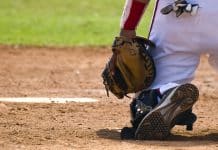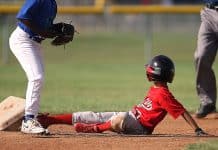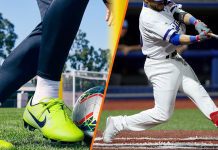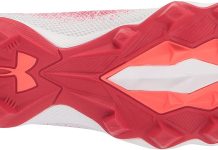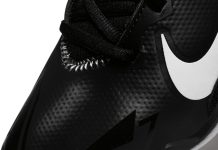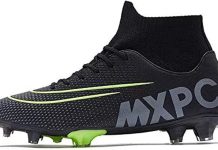Hey there! Ever wondered if baseball cleats have a toe cleat? Well, you’re in the right place! In this article, we’re going to explore the world of baseball cleats and uncover whether or not they come with a toe cleat. So, are you ready to dive into this cleat-tastic topic? Let’s get started and find out! Yes, many baseball cleats do have a toe cleat. The toe cleat is a small, metal spike located at the front tip of the cleat. It is designed to provide additional stability and traction for players when running, pivoting, and making quick movements on the field.
The toe cleat is especially important for baseball players as they need to have a solid grip on the ground when sprinting from base to base, stealing a base, or fielding a ball. It helps to prevent slipping and sliding, allowing players to maintain their balance and perform at their best.
There are various types of baseball cleats to choose from, each with its own unique features and benefits. Let’s take a closer look at the different types of baseball cleats available in the market.
Review contents
Metal Cleats
Metal cleats, also known as spikes, are the most traditional type of baseball cleats. They feature metal studs or spikes on the outsole, providing excellent traction on dirt or grass fields. Metal cleats are favored by many professional baseball players and serious athletes due to their superior grip and stability.
One of the main advantages of metal cleats is their ability to dig into the ground, allowing players to generate more power and acceleration with each stride. This is particularly beneficial for base runners trying to steal bases or outfielders running down fly balls.
However, it is worth noting that metal cleats are not permitted in all baseball leagues, especially in youth leagues. They can be dangerous if not used properly, as they can cause injury to other players when sliding or colliding. Therefore, it is important to check the regulations of your specific league before using metal cleats.
Molded Cleats
Molded cleats, also known as plastic or rubber cleats, are another popular choice among baseball players. These cleats have molded plastic or rubber studs on the outsole, offering good traction and stability on various playing surfaces, including grass, turf, and dirt fields.
Molded cleats are generally more comfortable and versatile than metal cleats. They provide a decent grip without the risk of causing injury to other players, making them a suitable option for players of all ages and skill levels. In addition, molded cleats are often more affordable than metal cleats, making them a popular choice for recreational players.
While molded cleats may not provide the same level of traction as metal cleats on wet or soft fields, they still offer sufficient grip for most playing conditions. They are also typically more durable and require less maintenance compared to metal cleats.
Turf Shoes
Turf shoes, as the name suggests, are specifically designed for playing on artificial turf surfaces. They feature a rubber outsole with numerous small rubber studs or knobs, providing excellent traction and grip on turf fields.
Turf shoes are lightweight and flexible, allowing for quick and agile movements. They are also known for their comfort and cushioning, making them a preferred choice for players who spend long hours practicing or playing on artificial turf.
Many players choose to wear turf shoes during practice sessions or warm-up drills, even if they primarily use other types of cleats during games. This is because turf shoes offer maximum comfort and convenience for activities that require a lot of running and lateral movements, without the risk of damaging the turf.
Now that we’ve explored the different types of baseball cleats, it’s time to delve into the functions and benefits they provide to players on the field.
Function of Baseball Cleats
Traction and Stability
One of the primary functions of baseball cleats is to provide traction and stability to players. As baseball is a sport that requires quick and explosive movements, it is crucial for players to have a firm grip on the ground to prevent slipping or sliding.
Cleats, whether metal or molded, are designed to dig into the ground when running or changing directions, allowing players to maintain their balance and move more efficiently. They provide the necessary traction to push off with power and make sharp turns without losing control.
In addition, cleats also help to stabilize the feet and ankles, reducing the risk of injuries such as sprained ankles or twisted knees. The spikes or studs on the outsole create a solid connection between the player’s feet and the ground, minimizing the chances of slipping or rolling the ankle.
Enhanced Performance
Baseball cleats can significantly enhance a player’s performance on the field. The improved traction and stability they provide enable players to run faster, make quicker cuts, and react more swiftly to different game situations.
With the right pair of cleats, players can generate more power with each step, translating into faster running speeds and better overall performance. They can also make more precise movements, such as pivoting to catch a ball or changing direction while running the bases.
Player Safety
Player safety is of utmost importance in any sport, and baseball is no exception. Wearing the correct type of cleats can help reduce the risk of injuries and keep players safe on the field.
The traction and stability provided by cleats prevent players from slipping or getting their feet stuck in the ground, which can lead to awkward falls or collisions. Cleats also offer additional support to the feet and ankles, reducing the chances of sprains or twists.
Furthermore, cleats help to protect the feet from impact and injuries. The durable materials and construction of baseball cleats provide a layer of padding and support, shielding the feet from potentially harmful objects or hard impacts.
Now that we understand the function and benefits of baseball cleats, let’s take a closer look at the different components that make up a pair of cleats.
Components of Baseball Cleats
Outsole
The outsole is the bottom part of the cleat that comes in direct contact with the ground. It is usually made of rubber, plastic, or a combination of both, depending on the type and quality of the cleat.
The outsole of metal cleats features metal spikes or studs, which provide excellent traction on various playing surfaces. The spikes are strategically placed to maximize grip and minimize slippage.
Molded cleats have studs or knobs made of rubber or plastic molded directly into the outsole. These studs are generally shorter than metal spikes and are distributed across the outsole in specific patterns to optimize traction and stability.
Turf shoes have small rubber knobs or studs that are dense and closely spaced, allowing for maximum grip on artificial turf surfaces. The outsole of turf shoes is typically non-marking, preventing any damage to the turf.
Midsole
The midsole is the layer of cushioning material located between the outsole and the upper. It plays a crucial role in providing comfort and support to the feet.
The midsole absorbs shock and impact, reducing the strain on the feet and legs during running and jumping. It also helps to distribute the pressure evenly across the foot, preventing hot spots or discomfort.
The type and thickness of the midsole can vary depending on the brand and model of cleats. Some cleats may have additional features in the midsole, such as gel inserts or air pockets, to further enhance cushioning and shock absorption.
Upper
The upper of the cleat is the part that covers the top of the foot. It is usually made of synthetic materials such as leather, synthetic leather, or mesh, which provide a combination of durability, breathability, and flexibility.
The upper of a baseball cleat should be snug and supportive, providing a secure fit to the foot. It should be flexible enough to allow natural movement of the foot but also sturdy enough to withstand the rigors of the game.
The upper may also have additional features such as overlays or reinforcements in high-wear areas to enhance durability and protection. Some cleats may also have extra padding or cushioning in the upper for added comfort and support.
Toe Box
The toe box is the front part of the upper that covers the toes. It is an important component of baseball cleats, especially those with a toe cleat.
The toe box should have ample room for the toes to move and flex comfortably. It should not be too tight or restrictive, as this can cause discomfort or restrict natural movement.
For cleats with a toe cleat, the toe box is often reinforced with additional padding or protection. This helps to shield the toes from impact or injuries, especially when running or sliding.
Now that we have covered the different components of baseball cleats, let’s explore the importance of the toe cleat specifically.
Importance of Toe Cleat in Baseball Cleats
The toe cleat in baseball cleats plays a crucial role in enhancing a player’s performance and safety on the field. Here are some of the key benefits of having a toe cleat in your cleats.
Increased Stability
The toe cleat provides an additional point of contact with the ground, increasing stability and balance for players. When running or making quick movements, the toe cleat helps to anchor the front of the foot, preventing it from sliding or shifting.
This added stability can be particularly beneficial when running on uneven or slippery surfaces. The ability to grip the ground with the toe cleat allows players to maintain their balance and control, reducing the risk of falls or missteps.
Improved Acceleration
The toe cleat also contributes to improved acceleration on the field. When pushing off with each stride, the toe cleat provides an extra source of power, allowing players to generate more force and speed.
The ability to dig into the ground with the toe cleat enables players to get a better grip and push off with maximum explosiveness. This can be especially advantageous for base runners, as it can help them sprint faster between bases or steal bases more efficiently.
Enhanced Traction
Traction is essential in baseball, as it enables players to make quick turns, stops, and cuts. The toe cleat adds another point of traction to the cleat, enhancing grip and preventing slippage on various playing surfaces.
The toe cleat is particularly useful when pivoting or making sudden changes in direction. It allows players to dig into the ground and push off without losing traction, ensuring maximum control and agility.
Overall, the toe cleat in baseball cleats provides significant advantages in terms of stability, acceleration, and traction. It can greatly contribute to a player’s overall performance and confidence on the field.
Now that we understand the importance of the toe cleat, let’s explore some baseball cleat brands that offer cleats with toe cleats.
Baseball Cleats with Toe Cleats
Several well-known baseball cleat brands offer cleats with toe cleats. Let’s take a look at some of these brands and the features they provide in their cleats.
Brands that Offer Baseball Cleats with Toe Cleats
-
Nike: Nike has a range of baseball cleats that feature toe cleats. Their cleats are known for their innovative designs, durability, and performance-enhancing features. Nike incorporates advanced technologies into their cleats, such as Flywire cables for lockdown support and Lunarlon cushioning for superior comfort.
-
New Balance: New Balance is a popular brand for athletes, and they offer baseball cleats designed with a focus on stability and support. Their cleats with toe cleats feature synthetic uppers for durability, cushioned midsoles for comfort, and metal cleats for exceptional traction.
-
Under Armour: Under Armour is known for its commitment to performance and innovation. Their baseball cleats with toe cleats are designed with superior traction in mind, utilizing metal cleats or a combination of metal and plastic studs. Under Armour cleats also feature supportive uppers and responsive cushioning for maximum comfort.
-
Adidas: Adidas is a trusted brand in the sports industry, and they offer a range of baseball cleats with toe cleats. Their cleats are known for their sleek design, lightweight construction, and excellent traction. Adidas incorporates technologies such as Adiwear outsoles and Boa closures for enhanced fit and performance.
These are just a few examples of the brands that offer baseball cleats with toe cleats. It is important to try different brands and models to find the cleats that best suit your needs and preferences.
Features of Baseball Cleats with Toe Cleats
Baseball cleats with toe cleats offer several features that can enhance a player’s performance and comfort on the field. Some common features to look for in cleats with toe cleats include:
-
Toe Cleat Design: The toe cleat should be strategically placed to ensure maximum stability and traction. Look for cleats with a well-positioned and durable toe cleat that can withstand the rigors of the game.
-
Upper Construction: The upper of the cleat should be sturdy and supportive, providing a secure fit without restricting movement. Look for materials that offer a combination of durability, breathability, and flexibility.
-
Cushioning and Support: The cleat should have adequate cushioning in the midsole and supportive features in the upper to ensure comfort and reduce the risk of injuries. Look for cleats with responsive cushioning and padding in the right areas.
-
Traction System: In addition to the toe cleat, consider the overall traction system of the cleats. Look for cleats with well-designed outsoles and studs that provide excellent grip on various playing surfaces.
By considering these features and trying on different brands and models, you can find the baseball cleats with toe cleats that meet your specific needs and preferences.
Now that we have explored the benefits and features of baseball cleats with toe cleats, let’s discuss the pros and cons associated with this type of cleat.
Pros and Cons of Baseball Cleats with Toe Cleats
Just like any other product, baseball cleats with toe cleats have their advantages and disadvantages. Let’s take a look at some of the pros and cons associated with this type of cleat.
Advantages of Baseball Cleats with Toe Cleats
-
Enhanced Grip: The toe cleats provide an additional point of contact with the ground, improving traction and stability. They allow players to push off with maximum power and make quick, explosive movements on the field.
-
Increased Speed: The toe cleats contribute to improved acceleration and speed. By generating more power with each stride, players can run faster between bases and make quick bursts of speed when needed.
-
Added Protection: The toe cleat offers extra protection to the toes, especially when running, sliding, or fielding. It helps to prevent injuries such as stubbed or jammed toes.
-
More Control: The toe cleat allows players to have better control and agility on the field. It enables quick pivots, sharp turns, and sudden changes in direction without losing grip or balance.
Disadvantages of Baseball Cleats with Toe Cleats
-
Potential for Injury: The metal spikes or studs on the toe cleat can pose a risk of injury, especially when sliding or colliding with other players. It is important to use caution and follow the rules and regulations of your specific league when wearing cleats with toe cleats.
-
Restrictions in Some Leagues: Certain leagues or organizations may prohibit the use of metal cleats or specific types of cleats, including those with toe cleats. It is essential to check the regulations of your league or consult with your coach or league officials before wearing cleats with toe cleats.
-
Specific Field Conditions: Cleats with toe cleats may not perform as effectively on certain field conditions, such as wet or soft fields. The metal spikes or studs can get clogged with mud or grass, reducing their traction and stability.
-
Slightly Heavier: Cleats with toe cleats may be slightly heavier than cleats without toe cleats due to the additional material and construction. Some players may find this added weight slightly uncomfortable or restrictive.
It is important to carefully consider these pros and cons and assess your specific needs and preferences before deciding on whether to purchase baseball cleats with toe cleats.
Now that we have covered the pros and cons, let’s discuss the maintenance and care required for baseball cleats with toe cleats.
Maintenance and Care of Baseball Cleats with Toe Cleats
Proper maintenance and care are essential to ensure the longevity and performance of baseball cleats with toe cleats. Here are some tips to help you keep your cleats in top condition.
Cleaning and Drying
After each use, remove any excess dirt or mud from your cleats. Use a soft brush or towel to gently scrub the outsole and remove any debris that may have accumulated.
If your cleats are particularly dirty, you can rinse them with water. However, avoid soaking them for extended periods or using harsh chemicals, as this can damage the materials or affect the performance of the cleats.
After cleaning, allow your cleats to air dry naturally. Avoid exposing them to direct sunlight or heat sources such as a dryer, as this can cause the materials to warp or deteriorate.
Storage
When not in use, store your cleats in a cool, dry place. Avoid leaving them in damp or humid environments, as this can lead to mold or mildew growth.
It is advisable to keep your cleats in a dedicated shoe bag or container to protect them from dust or damage. Ensure that the toe cleats are not pressing against any other objects, as this can cause them to bend or break.
Regularly inspect your cleats for any signs of wear or damage. If you notice any loose or missing spikes, frayed materials, or signs of deterioration, it may be time to replace your cleats.
By following these maintenance and care practices, you can prolong the lifespan of your baseball cleats with toe cleats and maintain their performance on the field.
Now that we have covered the maintenance and care of baseball cleats with toe cleats, let’s discuss some alternatives for players who prefer not to wear cleats with toe cleats.
Alternatives to Baseball Cleats with Toe Cleats
While baseball cleats with toe cleats offer specific benefits, some players may prefer alternatives for various reasons. Let’s explore two alternatives to baseball cleats with toe cleats.
Baseball Cleats without Toe Cleats
Cleats without toe cleats are a popular alternative for players who prefer a more traditional or versatile cleat design. These cleats often have a more streamlined profile and a uniform stud pattern on the outsole.
Baseball cleats without toe cleats can still provide excellent traction and stability on the field. They are suitable for players who prioritize lightweight and comfortable cleats without the added bulk of a toe cleat.
Modifying Regular Baseball Cleats
Another alternative is to modify regular baseball cleats by adding a toe cleat. This can be done by purchasing separate toe spikes or studs and attaching them to the front of the cleat.
Modifying regular cleats to include a toe cleat allows players to have the benefits of a toe cleat without having to purchase a new pair of cleats specifically designed with a toe cleat.
However, it is important to ensure that the modification is done properly to maintain the structural integrity and performance of the cleats. It is advisable to consult with a professional or experienced player before attempting any modifications.
Now that we have explored alternatives to baseball cleats with toe cleats, let’s discuss the regulations and guidelines surrounding the use of cleats in different baseball leagues.
Baseball Cleat Regulations and Guidelines
The regulations and guidelines regarding the use of baseball cleats can vary depending on the league, level of play, and age group. Let’s take a brief look at the regulations and guidelines for different baseball leagues.
Youth Baseball Cleats
In youth baseball leagues, there are often restrictions on the type of cleats that can be worn. Metal cleats are generally prohibited in most youth leagues, including Little League. This is to minimize the risk of injuries to players, as metal cleats can cause more severe injuries when sliding or colliding.
Molded cleats or turf shoes are usually allowed in youth leagues. These types of cleats offer sufficient traction and safety without the risk of causing harm to other players.
It is important to check the specific regulations of your youth league regarding the use of cleats to ensure compliance and player safety.
High School and College Baseball Cleats
High school and college baseball leagues typically allow the use of metal cleats. However, it is essential to check the specific rules and regulations of your school or league, as some organizations may have restrictions or specific guidelines regarding the length or material of metal spikes.
In addition, some high school and college leagues may require players to wear specific types of cleats for safety and uniformity purposes. It is crucial to familiarize yourself with the regulations of your league and consult with your coach or school officials if you have any questions.
Professional Baseball Cleats
In professional baseball, players have more flexibility in choosing their cleats. Metal cleats are commonly used by professional players, as they provide superior traction and performance on the field.
However, even in professional baseball, there may be specific regulations and guidelines regarding the use of cleats. These regulations are put in place to ensure fairness, player safety, and the integrity of the game.
As a professional player, it is important to stay updated on the rules and regulations of your specific league or organization and follow any guidelines regarding the use of cleats.
Now that we have explored the regulations and guidelines for different baseball leagues, let’s conclude the article.
Conclusion
Baseball cleats with toe cleats offer several advantages, including increased stability, improved acceleration, and enhanced traction. The toe cleat provides an extra point of contact with the ground, allowing players to perform at their best and reduce the risk of injuries.
Various brands offer baseball cleats with toe cleats, each with their own unique features and technologies. It is important to consider the specific needs and preferences of individual players when choosing cleats.
While baseball cleats with toe cleats have their advantages, they may not be suitable or allowed in all baseball leagues or playing conditions. It is important to check the regulations and guidelines of your specific league before wearing cleats with toe cleats.
Proper maintenance and care are essential to prolong the lifespan and performance of baseball cleats with toe cleats. Regular cleaning and drying, as well as proper storage, can help keep cleats in top condition.
For players who prefer not to wear cleats with toe cleats, there are alternatives available, such as cleats without toe cleats or modifying regular cleats.
Lastly, it is crucial to familiarize yourself with the regulations and guidelines for cleats in different baseball leagues. Compliance with these rules ensures fairness, player safety, and the overall integrity of the game.
With the right pair of baseball cleats, including those with toe cleats, players can enhance their performance, increase their comfort, and enjoy the game to the fullest.




